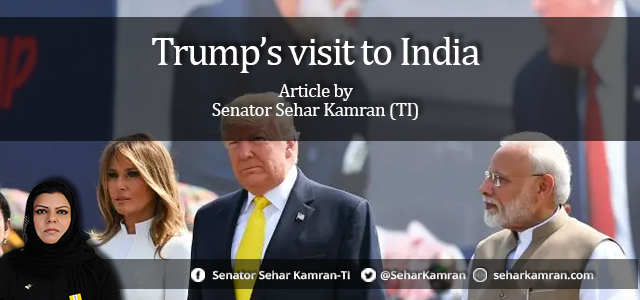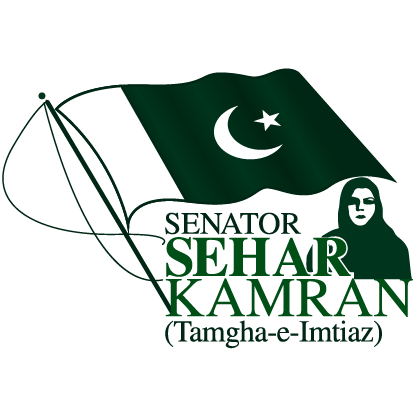By Senator Sehar Kamran (TI)
March 09, 2020
 “First, they came for the Socialists, and I did not speak out— because I was not a Socialist. Then they came for the Trade Unionists, and I did not speak out— because I was not a Trade Unionist. Then they came for the Jews, and I did not speak out—because I was not a Jew. Then they came for me—and there was no one left to speak for me”
“First, they came for the Socialists, and I did not speak out— because I was not a Socialist. Then they came for the Trade Unionists, and I did not speak out— because I was not a Trade Unionist. Then they came for the Jews, and I did not speak out—because I was not a Jew. Then they came for me—and there was no one left to speak for me”
—Martin Niemöller
In the last week of February, amid the ongoing riots and violent protests, the US President Donald Trump concluded his first two-day trip to India since assuming office in 2016. Trump’s visit to India highlighted the significance of the Indo-US relationship and took place ahead of the upcoming Presidential election, which will take place later this year. India is one of the few countries in the world where Trump’s personal approval rating is above 50 per cent. This visit marked the fifth meet in eight months between the two leaders.
The reason behind Trump’s visit to New Delhi was multifold. The first, obviously being the trade deals. Currently, the bilateral trade between the two countries stands at $160 billion dollars. It is no secret that President Trump wanted to secure a big trade deal in his election year, to please the domestic audience with his ‘deal-making skills’, but no such breakthrough took place. One development which needs to be noticed is the fact that prior to Trump’s visit, the US stripped India from ‘its list of developing countries that are exempt from investigations into whether they harm American industry with unfairly subsidized exports.’ It means that India will now be unable to reap the GSP benefits under the trade deal which is being negotiated between the two countries.
The second reason behind the visit was the China factor. It is no secret that the US-China relations during Trump’s tenure in office have been rocky, to say the least. The American President has not hesitated to censure Beijing on a number of issues, the foremost being trade agreements. Similarly, India fears China’s ever-increasing rise in the region, and has time and again presented itself as a regional counterweight. This visit to India has reiterated the strategic significance New Delhi holds for Washington. The US and India concluded a $3 billion deal. Under the agreement, New Delhi will buy ‘24 SeaHawk helicopters from Lockheed Martin equipped with Hellfire missiles and has plans to order six Apache helicopters.’ Apart from this, no major breakthrough deals occurred during this visit. The defence agreement can be viewed as a move to balance the rise of China in the region.
The third reason for this visit is the US domestic politics, upcoming elections, and appeasing the Indian American voters. Approximately 4.5 million people of Indian origin reside in the US, and they are a growing political force in the country. Many of them support Trump on his anti-Muslim rhetoric and appreciate his close friendship with the Indian Premiere Modi, especially the Hindu nationalists. These voters can play an important role in clinching the second Presidential term for Trump. This became evident as immediately after Trump’s visit to India, his ‘campaign launched a five-figure digital ad buy targeting Indian Americans.’ It is the first time that a Republican candidate is targeting this demographic on such a big scale. According to a senior official, the ad campaign is set to run for two weeks and it is currently targeting users on ‘Facebook, Instagram, YouTube, streaming services and other online publishers.’
Upon his arrival, the US President was given what was described as a “King’s welcome”. A “Namaste Trump” rally was held in the world’s biggest cricket stadium in Ahmedabad, Gujarat. It was attended by more than 100,000 people. However, despite the publicity and much hoopla created by the Indian government and officials, the US President’s visit was overshadowed by communal violence which resulted in the death of at least 47 people in the Capital city of New Delhi.
Even though when asked about the matter of India’s treatment of its minorities, the US President Trump tried to underplay the communal violence and the Indian state’s deliberate targeting of Indian Muslims through its controversial Citizen Amendment Act, by stating “that’s up to India”. His comments drew censure from all segments both nationally and internationally, including the Democratic Presidential nominee Senator Bernie Sanders who tweeted that President Trump’s refusal to address New Delhi’s mistreatment of Muslims was “a failure of leadership on human rights.”
The rising intolerance, religious extremism, communal violence, and deliberate targeting of the Indian Muslims by the RSS-led Hindu Nationalist government of Premiere Narendra Modi is a point of grave concern. Trump’s visit to India and the consequent violence which took place amplified the morose state of Indian Muslims and the organised state brutality being unleashed against them, just because of their religion.
It is no secret that the ground situation is indeed dire in India, and the world is not paying enough attention. The anti-Muslims programme being carried out by the extremist Hindutva government of PM Narendra Modi bears the hallmarks of the Nazi Kristallnacht. It seems, once again, history is repeating itself. The world powers must exert pressure on India and call New Delhi out on the inhumane treatment of its minorities because the worsening social and religio-political situation in India can jeopardise the peace of this already volatile region and the world, which is something nobody can afford at the moment.
Same version of the article appeared in The Nation


